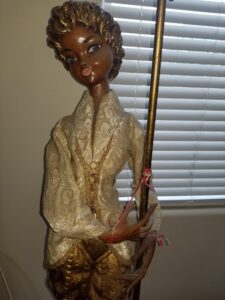 SS’s husband picked up a chalkware lamp at a garage sale. The figure shows the full body of a young gondolier with pink lipsticked lips, dressed in Venetian bloomers and a little vest. She sent me a photo a while ago, and now feels ready for me to write about this lamp. I know why she waited. Exotic lamps from the 19th century may have value. SS’s lamp is NOT 19th century, but very American mid-20th century. This lamp and Chalkware lamps like it are either not valuable at all, because of WHAT they represent, or to some collectors, priceless. They reflect a certain era and mind-set rather hard to imagine to us today.
SS’s husband picked up a chalkware lamp at a garage sale. The figure shows the full body of a young gondolier with pink lipsticked lips, dressed in Venetian bloomers and a little vest. She sent me a photo a while ago, and now feels ready for me to write about this lamp. I know why she waited. Exotic lamps from the 19th century may have value. SS’s lamp is NOT 19th century, but very American mid-20th century. This lamp and Chalkware lamps like it are either not valuable at all, because of WHAT they represent, or to some collectors, priceless. They reflect a certain era and mind-set rather hard to imagine to us today.
We call this genre early midcentury modern KITSCH, or put more nicely, midcentury Atomic. I didn’t make this up. I see those categories used at auction. The lamps are controversial today because they WERE NOT controversial when manufactured 1945-1960s. Typically these chalkware lamps (more about the material later) figures of “exotic” cultural men and women came as a HIS AND HER pair. The exotic in art is a relic from the Deco era, in which exoticism in the decorative arts was artistic and cross fertilizing. French Deco with the fine Egyptian flair makes a notable example.
Chalkware Lamps Seem Insulting Today
But when we hit the mid 1940s the syncretic flavor of early Deco devolves into, dare I say, ethnic stereotypes. I consider SS’s lamp a milder version, as it depics a sweet young Italian boy. Some chalkware lamps seem insulting today. His and Her Asian figures, African figures, Congo figures, Hawaiian figures, and because of the stereotyping, they fall outside of what collectors of midcentury modern WANT. What characterizes these chalkware lamps presents a frightening thematic ‘over the top’ quality. Not to mention the stereotypes, but these lamps were extremely popular. My grandmother owned a pair. I bet yours did too.
The category of these chalkware lamps falls outside our present craze for geometric midcentury modern, and inside early midcentury modern kitsch, or Atomic. The atomic moniker refers to something not related to the figures themselves, but to the SHADE. Yes, the shade on Atomic lamps come in fiberglass, sometimes threaded through with amoeba shaped lines. You get the picture.
SS’s lamp, with a Venetian figure MIGHT have come with a Venetian blind style SHADE, no kidding. Those became popular because you pulled a tiny cord to raise the lamp shade, and they were usually in that thin metal of 1950’s Venetian BLINDS. Thematic literalism.
The best of these lamps are not chalkware, a fancy way of saying plaster poured into a mold, but gypsum. Early 19th century figural lamps are NOT chalkware, and can be valuable.
Chalkware Special Mass Produced Quality
One factory that made these his and hers (mated) thematic lamps (usually for the top of the TV set!) was Reglor. Their Harem man and captured woman in turquoise harem pants with a threaded fiberglass shade sells for $800 a pair. “Keen” (an old word) colors were favored, such as reds, blacks, golds, greens, and pinks. The Continental Art Company, whose light-touch yellow/green Fairy pair, one young fairy boy, one girl, with fiberglass shades with a cloud-lace design, sells for $500 a pair. Continental also made a Native American mother and child in papoose with a wicker inverted basket shade.
Perhaps the best name ever for these lamps was “Plasto,” a factory which made themselves famous by their fake plaster driftwood pairs of lamps. Also their Revolutionary Era Militia soldier lamp, who carried a drum and a musket. The shade was olde worlde patriotic symbols superimposed on a map of Olde Virginny.
Perhaps the most alarming chalkware lamps I’ve seen are the pair of gyrating Conga dancers in radiation green. Him with exposed chest, drum between the legs, a vest with ruffled sleeves, bare feet, turban. Her with a split skirt, a ruffled bra, ruffled sleeves, one arm raised, surmounted (each) by a double tiered fiberglass shade, the top shade rising above the whole lamp, the smaller of the two shades, alternating white and green.
The value of SS’s lamp is $750.
Pingback: Art Nouveau Floor Lamp - Elizabeth Appraisals
Pingback: Spanish Colonial Revival Floor Lamp Tells Story - Elizabeth Appraisals
Pingback: Cringeworthy Midcentury Table Lamps - Elizabeth Appraisals